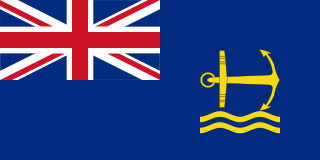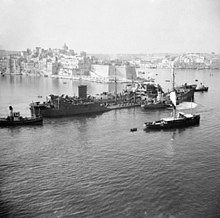
The Royal Maritime Auxiliary Service(RMAS) was a British Government agency which ran a variety of auxiliary vessels for His Majesty's Naval Service (incl. Royal Navy, Royal Marines and Royal Fleet Auxiliary). The service from 2009 has been run by Serco and is known as Serco Marine Services.

His Majesty's Naval Service is the United Kingdom's naval warfare and maritime service. It consists of the Royal Navy, Royal Marines, Royal Fleet Auxiliary, Royal Naval Reserve, Royal Marines Reserve and Naval Careers Service. The Naval Service as a whole falls under the command of the Navy Board, which is headed by the First Sea Lord. This position is currently held by Admiral Sir Ben Key. The Defence Council delegates administration of the Naval Service to the Admiralty Board, chaired by the Secretary of State for Defence.
The Admiralty Yard Craft Service was the civilian service which operated auxiliary vessels for the British Admiralty, mainly in HM Dockyards or the vicinity. It was renamed the Port Auxiliary Service (PAS) on 1 October 1958 and the Royal Maritime Auxiliary Service in 1976.

Henry Robb, Limited, known colloquially as Robbs, was a Scottish shipbuilding company based at Leith Docks in Edinburgh. Robbs was notable for building small-to-medium sized vessels, particularly tugs and dredgers.

A net laying ship, also known as a net layer, net tender, gate ship or boom defence vessel was a type of naval auxiliary ship.

Naval trawlers are vessels built along the lines of a fishing trawler but fitted out for naval purposes; they were widely used during the First and Second World Wars. Some—known in the Royal Navy as "Admiralty trawlers"— were purpose-built to naval specifications, others adapted from civilian use. Fishing trawlers were particularly suited for many naval requirements because they were robust vessels designed to work heavy trawls in all types of weather, and had large clear working decks. A minesweeper could be created by replacing the trawl with a mine sweep. Adding depth charge racks on the deck, ASDIC sonar below, and a 3-inch (76 mm) or 4-inch (102 mm) gun in the bow equipped the trawler for anti-submarine duties.
Naval trawlers were purpose-built or requisitioned and operated by the Royal Navy (RN), mainly during World Wars I and II. Vessels built to Admiralty specifications for RN use were known as Admiralty trawlers. All trawlers operated by the RN, regardless of origin, were typically given the prefix HMT, for "His Majesty's Trawler".

The Ville-class harbour tugboats are a class of tugboats employed by the Royal Canadian Navy.

The Glen-class tug is a class of naval tugboat operated by the Royal Canadian Navy. Constructed in Canada, the class entered service between 1975 and 1977. The five vessels that comprise the class are split between the two major naval bases of the Royal Canadian Navy. The Royal Canadian Navy operated a fleet of tugboats during the Second World War which were also named the Glen class. The vessels of the current Glen class are each named after one of the vessels of the earlier class.
DMS Maritime, formerly Defence Maritime Services, is a company providing port services to the Australian Defence Force and Marine Unit. It is a subsidiary of Serco.
The Ministry of War Transport (MoWT) was a department of the British Government formed early in the Second World War to control transportation policy and resources. It was formed by merging the Ministry of Shipping and the Ministry of Transport, bringing responsibility for both shipping and land transport to a single department, and easing problems of co-ordination of transport in wartime.

An armed yacht was a yacht that was armed with weapons and was typically in the service of a navy. The word "yacht" was originally applied to small, fast and agile naval vessels suited to piracy and to employment by navies and coast guards against smugglers and pirates. Vessels of this type were adapted to racing by wealthy owners. The origin of civilian yachts as naval vessels, with their speed and maneuverability, made them useful for adaptation to their original function as patrol vessels. In the United States Navy armed yachts were typically private yachts expropriated for government use in times of war. Armed yachts served as patrol vessels during the Spanish–American War and the World Wars. In the latter conflicts, armed yachts were used as patrol vessels, convoy escorts, and in anti-submarine duties. In the United States, yachts were purchased from their owners with the owners given an option to repurchase their yacht at the close of hostilities.

The Fire-class fireboats/yard tractor tugs were two fireboats operated by the Royal Canadian Navy. The two vessels are CFAV Firebrand and CFAV Firebird.

The Wave class was a class of replenishment oilers built for service supporting the Royal Navy during the later years of the Second World War. They were subsequently transferred to the Royal Fleet Auxiliary after the end of the war, and went on to support British and allied fleet units in Cold War conflicts such as the Korean War.
The Victualling Inshore Craft, or VIC, was a type of auxiliary vessel built for the Royal Navy during the Second World War. The VIC was modelled on the Clyde puffer, and over 100 were built during the conflict.

HMS Paladin was a Admiralty M-class destroyer which served with the Royal Navy during the First World War. The M class were an improvement on the previous L-class destroyer, capable of higher speed. Launched on 27 March 1916. Paladin took part in the Royal Navy sorties against German minesweepers in 1917, which culminated in the Second Battle of Heligoland Bight on 17 November, although the destroyer did not engage with any enemy warships during the battle. After the end of the war, the ship was placed in reserve before being decommissioned and sold to be broken up on 9 May 1921.
Several ships of the British Royal Navy have borne the name Bustler:













